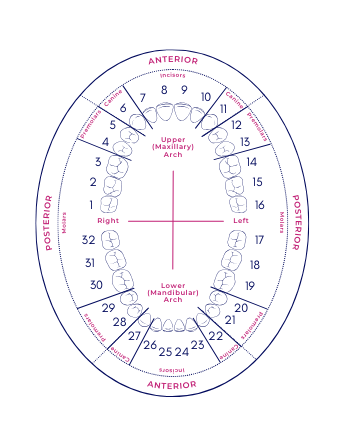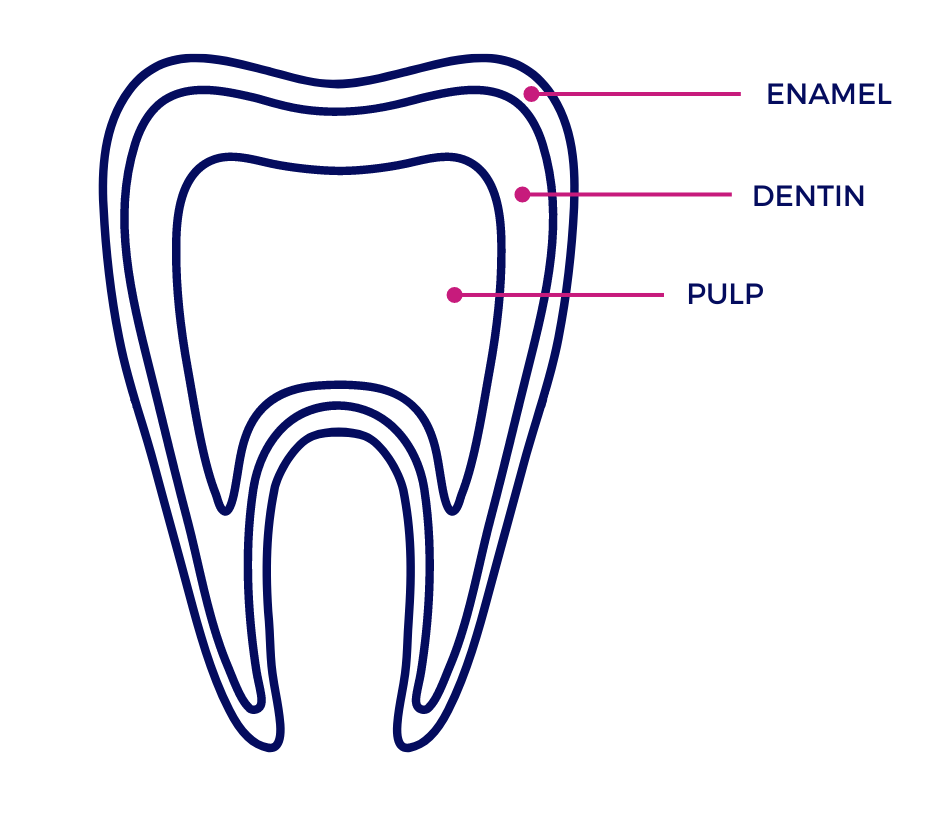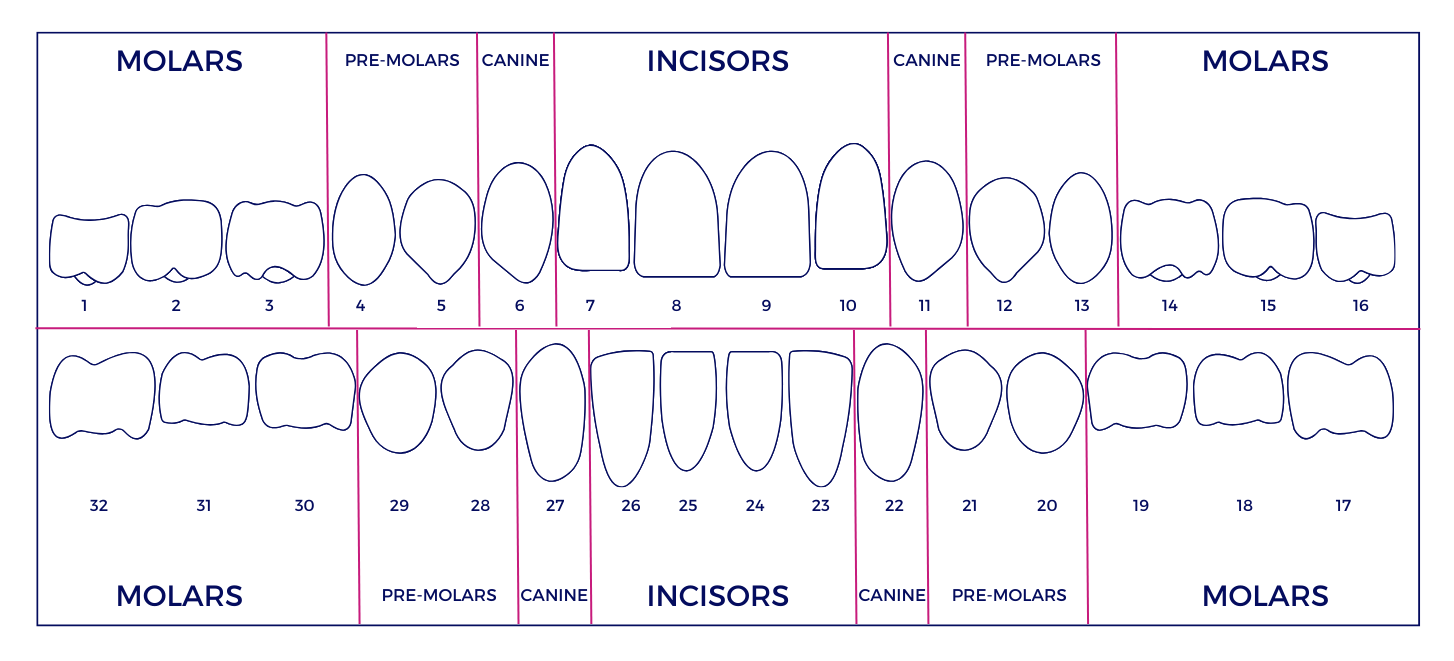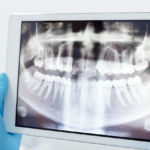Have you ever wondered what your dentist is saying when they start using dental terminology and codes during your appointment? Having an understanding of basic tooth anatomy and dental terminology can help alleviate dental anxiety and empower you to make informed decisions about your dental care and improve your overall dental health.
Let’s start with the basics.

The Mouth
Your mouth is split into two arches. The upper half is called the Maxillary arch. The lower half is called the mandibular arch. Regardless of whether you have all your adult teeth, had teeth removed, or experienced damage, adults typically have 32 teeth. They are called permanent or secondary teeth, that include:
As a dentist, I number the teeth using the Universal Standard. Meaning, I number your teeth right to left starting in the upper right corner of the mouth. Then continue numbering from left to right in the lower left side of the mouth. (See Diagram to left)
- The back teeth are known as posterior teeth which include your premolars and molars.
- The front teeth are known as anterior teeth and include your canines and incisors.
The Tooth
- 12 molars, including 4 wisdom teeth
- 8 premolars
- 4 canines
- 8 incisors
The tooth has three layers: the enamel, dentin, and pulp. 
- Enamel: The visible, white outer layer. It is the hardest tissue in the human body and provides protection to the inner layers of the tooth against decay or injury.
- Dentin: The middle layer of the tooth is similar to bone tissue. It forms the majority of the tooth structure and contains millions of tiny tubes that connect it to the pulp. The dentin protects the pulp.
- Pulp: the innermost layer of the tooth and serves as the life-source of the tooth. The pulp consists of blood vessels and nerves that provide nourishment and sensory function to the tooth.
The crown refers to the part of the tooth that is visible above the gumline, while the root, which connects the tooth to the jawbone, is located below the gumline.
Categories of Teeth
Starting in the front, what are incisors?
The front part of your mouth contains eight incisor teeth – four in the upper jaw and four in the lower jaw – which are shaped like small chisels with sharp edges to help you bite into food. They are the front line whenever you take the bite out of something, such as an apple or corn on the cob.
Your incisors include tooth numbers: 7, 8, 9, 10, 23, 24, 25, 26
What are canines?
The canines, which have a sharp, pointed surface for tearing food, are located next to the incisors. Sometimes referred to as your vampire teeth. There are two canines on the top and two on the bottom of your mouth.
You canines include tooth numbers: 6, 11, 22, 27
What are premolars?
Located next to the canines, there are eight premolars in total – four on the upper jaw and four on the lower. Compared to canines and incisors, premolars are larger and have a flat surface with ridges that helps to break down food by crushing and grinding it into smaller pieces, making it easier to swallow.
Your pre-molars include tooth numbers: 4, 5, 12, 13, 20, 21, 28, 29
What are molars?
Your largest and most robust teeth are the 12 molars, six of which are located in the upper jaw and six in the lower. The extensive surface area of your molars enables them to grind food effectively. After your tongue pushes food to the back of your mouth while eating, your molars break it down into smaller pieces that are easier to swallow.
Your molars include tooth numbers: 1, 2, 3, 14, 15, 16, 17, 18, 19, 30, 31, 32
Your molars also include your wisdom teeth, tooth numbers: 1, 16, 17, and 32. Typically your wisdom teeth are the last set of teeth to grow in, between the ages of 17 and 25. However, every mouth is different. In some cases there isn’t enough space in the mouth to accommodate these four additional teeth.Which can result in the wisdom teeth becoming impacted, which means they are trapped under the gums and cannot grow-in properly. If this happens, extraction may be necessary.
 Tooth Surface
Tooth Surface
To identify teeth and refer to specific areas of a tooth, it’s essential to use named surfaces and directions that are designated based on their location. See diagram to the right.
- Distal (D)– The surface that is away from the midline of the face.
- Facial (F)– The surface that faces the cheeks or lips. Can also use the terms:
- Labial (L)– The surface towards the lips.
- Buccal (B) – The surface towards the cheeks.
- Incisal (I)– The biting edge of an anterior tooth.
- Lingual (L)– The surface that faces the tongue.
- Mesial (M)– The surface that is closest to the midline of the face.
- Occlusal (O)– The chewing surface of posterior teeth.
- Proximal – Tooth surfaces that are next to each other (i.e., distal of lateral incisor and mesial of canine).
Common Dental Procedures
Prophy: Teeth cleaning, a routine dental procedure to remove plaque, tartar, and surface stains from teeth.
- The Dentist or hygienist will use a tool referred to as a “scaler”, it will vibrate and spray water as they clean along the gum line of the teeth.
Filling: A dental restoration to repair a cavity or damaged tooth with a material such as composite resin, amalgam, or porcelain. Anesthetic will be needed.
This is when the doctor will say a specific tooth number with the first letter of the tooth surface or surfaces that are in need of this restorative work.
For example:
- Dentist: 4-DO
Translation: Tooth #4 needs a filling on the distal-occlusal surface.
Endodontics (or Endo, means root canal): a procedure to remove infected or damaged tissue from inside a tooth and fill it with a filling material. In most Endo cases, the tooth will require a dental crown. Anesthetic will be needed.
For example:
- Dentist: 14-Endo, build-up & crown
Translation: Tooth number 14 needs a root canal, we can do it here, it will need a crown
Or
- Dentist: Refer 14-Endo
- Translation: Tooth number 14 needs a root canal, let’s refer to a Endodontist (a specialist)
Crown: a dental cap that covers and protects a damaged or weakened tooth, restoring its shape and function. Most crowns will also require a build-up, but in some cases it may not be necessary. Anesthetic will be needed.
Build-up: a composite material used to fill in a missing or damaged part of a tooth to restore its shape and function.
Extraction: the removal of a tooth, usually due to severe decay, fracture, infection, or crowding. Depending on the severity of tooth decay or the way it broke, it will either be a simple extraction or a surgical extraction. If infection is present, antibiotics may be recommended before extracting. Anesthetic will definitely be needed.
Periodontal treatment: procedures to treat gum disease, including scaling and root planing, antibiotic therapy, and surgical procedures.
- Scaling and Root Planning, aka SRP: A deep cleaning procedure that removes tartar and bacteria from below the gumline to treat gum disease. This will be done in two visits, and will require anesthetic.
- Full Mouth Debridement: A preliminary cleaning procedure for patients with severe plaque and tartar buildup that makes it difficult to perform a comprehensive exam.
- Perio Maintenance: A follow-up cleaning procedure for patients who have undergone periodontal treatment to maintain healthy gums and prevent further damage. Based on the
- Perio Charting: A diagnostic procedure that measures the depth of the spaces between the gums and teeth to determine the extent of gum disease.
Dental Specialists:
- Endodontist: Specializes in diagnosing and treating issues related to the dental pulp and nerves.
- Orthodontist: Specializes in correcting misaligned teeth and jaws.
- Periodontist: Specializes in treating and preventing gum disease.
- Pediatric Dentist: Specializes in treating children’s dental health.
- Oral and Maxillofacial Surgeon: Specializes in diagnosing and treating diseases, injuries, and defects in the mouth, jaw, and face.
- Prosthodontist: Specializes in the restoration and replacement of teeth with artificial ones.
- Oral Pathologist: Specializes in diagnosing and treating diseases of the oral and maxillofacial region.
- Public Health Dentist: Focuses on promoting oral health in communities and preventing dental diseases.
- Cosmetic Dentist: Specializes in enhancing the appearance of teeth and gums through various cosmetic procedures.
Conclusion
By knowing dental terminology and tooth anatomy, it can help make your dental visits a little less intimidating by unlocking a world of better dental health. Armed with this knowledge, you will be able to have more meaningful conversations with your dentist, ask informed questions, and take better care of your teeth. empower you to make informed decisions about your dental care. So remember, with great dental knowledge comes great dental responsibility.





